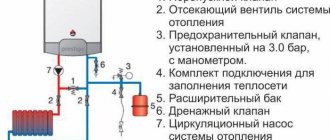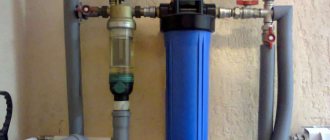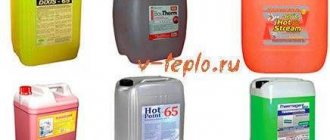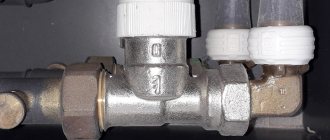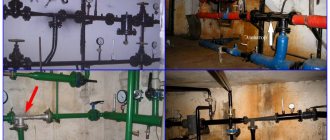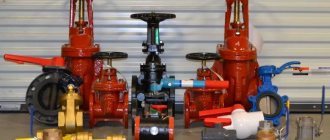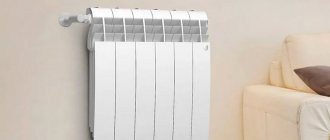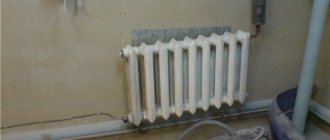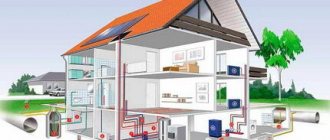A properly designed heating system is a combination of elements that provide a comfortable temperature in residential, commercial, and industrial premises. Mandatory components of the heating system include: boiler, radiators, pipes. But the system also includes control components - fittings for heating systems, without which automatic operation of the complex is impossible. Therefore, its installation is an important aspect of the construction of a heating system.
Before arranging a heating system, it is necessary to understand the role played by a certain type of fittings. The general purpose is to adjust the amount of coolant and distribute it along the circuits of the system, reducing/increasing the volume of coolant in certain cases.
Heating control valves
It is designed to control the operation of the heating system as a whole or in a specific area. This depends on the design and operating parameters. Let's consider the most popular and mandatory models for installation.
Mayevsky crane
Design of the Mayevsky tap
If the heating of a certain radiator has significantly deteriorated, there is a high probability of an air lock. To prevent overheating of the coolant, it is necessary to pre-install Mayevsky taps on each of the heating devices.
This heating control valve is a needle valve that is completely sealed when closed. Installed on the upper radiator pipe, in case of air pockets it helps to eliminate them. To do this, use a key or screwdriver to loosen the degree of pressure on the curtain. This is done until the characteristic sound of escaping air is heard. The procedure ends only when the coolant begins to flow.
Check valve
Check valve
Necessary to prevent reverse movement of water in pipes. It can be found in catalogs of heating fittings intended for both small private systems and central heating.
The operating principle of this device is based on the fact that the pressure of the water pressure acts on the valve seat, moving it away. As a result, fluid circulates in the pipes. If for some reason water begins to flow back, the valve returns to the closed state. This mechanism is necessary in systems with complex wiring of highways. In particular, it is mounted as a shut-off valve for heating radiators. This improves operational safety and increases the efficiency of the entire system.
Mixing units
Two way valve
To install a water heated floor, it is necessary to ensure mixing of hot and cold water. This is due to different temperature conditions in the heating pipes and underfloor heating. 2 or 3-way mixing units are used as the main mechanism.
Structurally, they are similar to needle taps. But in addition to the inlet and outlet pipes, they have additional connection points. Two-way models provide mixing of coolant flow with different temperatures by opening the rod to a certain height. In three-way designs, dampers are installed. Changing their location reduces or increases the flow of water.
Such control valves for heating can be controlled manually or automatically. For the latter, an electric drive is installed connected to a temperature sensor in the pipes or in the room. Depending on the set heating level, the position of the rod or damper is adjusted.
Safety valve
If the heating level of water in the pipes exceeds the specified parameter, a sharp rise in pressure occurs. To prevent a breakthrough, another type of heating shut-off valve is installed, the regulating functions of which are aimed at discharging excess water or air from the system.
The most popular of them is the safety valve. Unlike the Mayevsky tap, it is designed for higher pressures. In the event of an emergency, water pressure acts on the seat, causing the rod to rise. Excess coolant or air leaves the system, and the valve remains open until the pressure stabilizes. This shut-off valve for heating must be installed correctly. Experts recommend installation on the return pipe before it enters the boiler and before the circulation pump.
Direction of coolant circulation
The lower saddle connection of the batteries using a lower vertical collector allows you to not depend on the direction of coolant supply. This cannot be said about the lateral and diagonal leash, as well as when radiators with a bottom connection point are used: here the supply must be clearly adjusted. Otherwise, the heating of the device may stop completely, or it will heat up very weakly. A lateral or diagonal connection involves the use of a top feed (the return pipe in this case comes from below).
When installing a bimetallic radiator with a bottom connection, it is important to clarify in advance which of the inputs will be connected to the supply. Usually this information is indicated in the passport
It is important not to confuse the directions, because... The supply in such heating devices is equipped with a tube extending upward from the inlet assembly. With its help, the coolant is brought to the upper collector. After this, it spreads over the radiator.
Shut-off and control valves - characteristics and purpose
An important indicator of shut-off valves for water supply is throughput. This is the main characteristic that determines the selection of other parameters. Bandwidth is divided into several other types that allow you to fully describe the operation of the system.
Relative leakage is one of the main indicators that allows you to determine leaky sections of pipes, as well as the likelihood of a possible leakage of a substance. The control valves must provide the required level of tightness. In some cases, other indicators are determined to assess the quality of the system.
Main parameters of control valves
The structural element allows you to adjust the following indicators:
- temperature regime of the functioning of the environment;
- distribution of the substance within the pipeline system;
- different types of pressure in the system;
- compliance with the correct distribution of substances and proportions in the working environment;
- maintaining fluid at the same level.
It does not matter what brand of parts will be installed. They are identical in structure, so they are completely suitable for different characteristics.
Types of shut-off and control valves
There are several different types of shutoff valves. The classification depends on the functional features of the device. The following types of devices are distinguished:
- Constipation. Required to completely shut off the operating current. Most often used to equip heating and plumbing systems.
- Regulatory. Used to control the basic characteristics of the system. Allows you to adjust pressure, temperature, concentration and other indicators.
- Shut-off and regulating. A multifunctional device that blocks or regulates the main flow.
- Emergency. Eliminates possible consequences of system failure. Protects other areas from the spread of the problem.
- Safety. The design is triggered in the event of an accident. Otherwise not used.
- Mixing. Allows optimal distribution and direction of working fluids. Installed in heating systems to ensure the required temperature conditions.
- Phase separating. Distributes the work environment by functionality.
Recommended Manufacturers
Several global manufacturers are engaged in the production of such shut-off and control valves. The operation of the heat supply depends on the quality of materials, accuracy of settings and design. Therefore, it is recommended to buy original models rather than analogues. This will increase the reliability of the system.
You can find balancers on the market from Valtec, Danfoss, Herz and Honeywell. They differ only in appearance, their functional features are the same. The table shows popular heating balancers from these manufacturers.
| Manufacturer | Mechanical balancer | Automatic balancer |
| Valtec | VT.042.G | VT.040.G |
| Danfoss | Leno MVT or MNT | AB-PM, APT or ASV |
| Herz | 4017 M | TS-V |
| Honeywell | Kombi-3-Plus | — |
These models differ in size and connection methods to the pipeline. Some of them are designed only for cold water supply, but most are universal and can be used for heating and water supply. An example is Danfoss products. Air valve for heating to bleed air from the battery In modern heating systems, a special device is provided to remove accumulated air - an air valve for heating. Without this device, the heating would not be able to work properly....
Classification of shut-off valves according to the method of flow regulation
Water fittings are classified depending on the methods of regulating the working fluid. Below are the possible options.
Crane characteristics
The following types of structures are distinguished:
- Cork. Used for transporting industrial liquids.
- Ball. Used in everyday life.
The system structure consists of a locking part and a working body. The product differs in performance from maximum to minimum. The adjustment is carried out using a special switch. There are automatic systems.
The main working element is the ball, which performs the function of constipation. It is located between the control holes. The system parameters depend on the pipe diameter. When the valve opens or closes, the ball moves.
The product is characterized by high sensitivity and low tightness. Some species exhibit resistance to aggressive chemicals, high temperatures and other parameters.
Shut-off valves
Mainly used to shut off flows of working substance. A special valve allows you to switch modes. Different types of construction are characterized by different connections.
Most often, valves are used to regulate pressure in large lines. The operating principle of the design is as follows:
- When the valve rotates, the movement is directed towards the spindle.
- Structural elements rotate under pressure.
The system starts manually. There are automatic designs. There is high hydraulics and low counter pressure, which is the main disadvantage.
Features of dampers
The equipment is used in low pressure systems. Allows for increased tightness. The mains are located in sewers or are intended for transporting specific liquids. A disk is used as a locking element, which rotates around an axis.
Valves
It is simple and easy to use. Shows high resistance to aggressive working environment conditions. Most often used in large industrial highways. The working part rotates around its axis.
The valves have a simple design and easy maintenance. It is small in size, which allows for quick installation of the structure.
Design Feature
To stabilize the pressure, you can choose a mechanical or automatic balancing valve for heating, which differ in design. The former are adjusted manually; to change the pressure difference, it is necessary to control the position of the rod each time.
If it is necessary to automate the operation of heat supply, it is recommended to choose models with a membrane unit.
Mechanical balancers
This is one of the types of shut-off valves, the position of the rod in which is adjusted manually.
The handle has a digital scale indicating the current flow rate in the pipeline. The advantage is that it can be used for balancing and as a shut-off valve. Example: shutting down individual sections of a pipeline for repair work. Additionally, you can install a pressure gauge and thermometer to monitor pressure and temperature. But for this you need to choose models with appropriate connectors. The material of manufacture is brass, less often stainless steel is used. When choosing, you need to pay attention to the maximum pressure that the device can withstand.
Automatic balancers
They consist of two components - a mechanical valve and a differential pressure regulator. In the first, a membrane block is installed; there are 2 fittings on the body, which are connected to a pressure gauge for adjustment or to a differential pressure regulator. When pressure changes, the thickness of the membrane block increases or decreases, thereby regulating the working passage of the line. Mounted on the return line.
The differential pressure regulator is installed on the supply pipeline. Connects to a mechanical balancer using capillary tubes. When heating parameters change, the pressure is automatically adjusted.
For large, branched systems, it is recommended to install automatic balancers. This is relevant for frequent pressure changes and changes in coolant temperature. If the system operates relatively stably, but you need to periodically monitor the hydraulic parameters, you can install mechanical balancers.
Shut-off valves
The most common example of a shut-off device is a simple ball valve. It has only 2 working positions: “open” or “closed”. Due to its design, when open, the valve allows a flow of liquid through itself without changing its direction or flow area. It is a brass body with a built-in element in the form of a ball with a hole, rotating a rod with a handle, as shown in the diagram:
Section of shut-off valves
The polished steel ball is sealed with polymer material and can rotate 90º. As can be seen from the diagram, the design of the control valves also allows the flow to be blocked not completely, but this method of control is not used. Firstly, it is too rough, and secondly, the hole of the ball, rotated at some angle, creates high hydraulic resistance to the flow of liquid.
Stopcock with filter
Three way valve
In water heating systems, shut-off ball valves are used in the following places:
- cutting off radiators from the system for the purpose of their periodic maintenance;
- to disconnect branches and risers;
- shutting off the flow to remove or repair heating and pumping equipment, expansion tanks;
- for emptying and refilling the system.
Electric crane
Shut-off devices also include check valves and various shut-off valves with electric drive. It should be noted that in systems of private houses and apartments, shut-off and control valves with an electric drive are very rarely installed, unless in complex and branched circuits controlled by automation.
Valve
As for check valves, their task is to pass the coolant in full in one direction, and to tightly shut it off in the other. Place of installation of elements - boiler piping diagrams and other special cases when it is necessary to avoid the reverse movement of water.
Why are cranes needed?
First of all, it should be said that people commonly call a faucet any device for controlling the flow of liquid that has a handle. Technically, it is more correct to call taps shut-off valves.
Moreover, the latter only allows you to completely shut off or open the coolant flow, but not to regulate its flow. Valves and valves are used for regulation.
As a rule, control valves are installed at the entrance to the radiator, which performs the following functions:
- Allows you to disconnect the battery, which may be necessary for various reasons.
- Allows you to shut off the coolant for washing the device or inspection.
- In manual or automatic mode, it regulates the flow of coolant and thereby the temperature of the radiator.
It should be taken into account that different types of fittings may have different functions. Below we will get acquainted with the features and design of all types of taps that are used in conjunction with radiators of the heating system.
Ball valve design diagram
Pipeline accessories
Production of pipeline fittings
Pipeline fittings are equipment installed on pipelines and designed to control the flow of working media in pipelines by changing the flow area. Management refers to the distribution and regulation of working environments, as well as their shutdown and mixing. Working media can be liquid, gaseous, powdery, suspension, etc.
Pipeline fittings and equipment are divided according to their functionality into shut-off, control, safety, protective, phase separating and distribution. Let us tell you in more detail about each class of pipeline fittings.
Shut-off valves
Shut-off valves are designed to shut off the flow of medium in a pipeline. Shut-off valves are divided into the following popular types: ball valves, various gate valves, gate valves, wedge gate valves.
The ADL pipeline valves catalog has the most complete line of shut-off valves for use in engineering systems of housing and communal services and construction, as well as in industrial enterprises. We produce and sell such pipeline fittings as: steel ball valves "Bival", butterfly valves "Granval", check valves "Granlok", wedge gate valves "Granard". The ADL company produces reliable, easy-to-use, durable shut-off pipeline valves for heat supply systems, gas supply, refrigeration, air conditioning and industry.
Control valves
Control valves are a type of pipeline fittings designed to regulate the parameters of the working environment. The concept of parameter regulation includes regulating the flow of the medium, maintaining the pressure of the medium within specified limits, mixing various media in the required proportions, maintaining a given level of liquid in vessels and some others.
Control pipeline fittings can be divided into two groups:
- Direct-acting control valves (the movable element of the valve is driven by the energy of the working medium). This group includes direct-acting pressure regulators, level regulators, etc.)
- Indirect-acting control valves (the moving element of the valve is driven by external energy - for example, electrical energy or compressed gas energy).
Safety fittings
Safety valves are designed to prevent an emergency increase in any parameter in the working environment by selecting an excess amount of medium. For example, safety valves have this function.
ADL produces pipeline fittings and this type - Pregran safety valves.
Safety valves are designed to protect equipment from emergency excess of any parameter of the working environment (pressure, temperature, etc.) by disconnecting the pipeline section. For example, check valves.
Check Valve
The use of this type of control valve makes it possible to prevent water hammer and thereby helps to increase the reliability of the entire heating structure. The valve prevents reverse circulation of the heated liquid through the system. In order for the device to be acceptable in combination with the circuit, it must be selected taking into account the diameter inside.
The main element of a check-type valve is a spring, which serves to hold the rod and closes it if a dangerous situation occurs in the circuit.
Useful tips for choosing
Several features are described below in order to decide which products are best to use.
Locking mechanism
Thermostats have two types of locking mechanisms: a valve and a valve with a cone (rod). The latter is preferred, it allows for smooth adjustment. The temperature is set manually using a mechanical limiting ring. There are also electronic mechanisms, they are more autonomous.
It is better to install ball valves than gate valves, which have a number of disadvantages: the seal wears out faster, becomes overgrown with deposits, and takes a long time to close. Disadvantages of the Mayevsky crane: low maneuverability, it requires a special key or screwdriver, which is inconvenient to use. If its rod is accidentally unscrewed, it is very difficult to screw it back, overcoming the water pressure. Instead, it is recommended to install a regular valve or special automatic radiator air vents. The optimal and affordable option if temperature control is required is a faucet with a thermal head.
Housing and connections
It is better to install not standard ball valves on batteries, but full bore ones. In residential buildings and apartments, such mechanisms with a coupling connection are used.
It is better to choose taps for heating radiators with a steel or bronze body, but most often they use brass ones, since they are cheaper. An imitation of brass is silumin. You should not buy a product made from it; it is a very soft metal. Polymer ones are no less reliable, but they have large dimensions. To replace them, you need to cut out a piece of pipe.
Products with polymer rather than rubber gaskets are more durable. The taps for adjusting the coolant on heating radiators make it impossible to change them without draining the water; this can be done with straight-through taps or with an American valve installed (towards the battery).
Products from Itap (Italy) and Danfoss are considered to be of the highest quality. Approximate price range 700–2000 rub. In the middle price range there are Oventrop brand products - 550–950 rubles. For a limited budget, Luxor is suitable - 450–800 rubles, Chinese or Turkish brands.
What is needed for installation
Installation of heating radiators of any type requires devices and consumables. The set of necessary materials is almost the same, but for cast iron batteries, for example, the plugs are large, and they do not install a Mayevsky valve, but instead, somewhere at the highest point of the system, they install an automatic air vent. But the installation of aluminum and bimetallic heating radiators is absolutely the same.
Steel panel ones also have some differences, but only in terms of hanging - they come with brackets, and on the back panel there are special arms cast from metal, with which the heater clings to the hooks of the brackets.
These are the arms that hook the hooks
Mayevsky crane or automatic air vent
This is a small device for releasing air that may accumulate in the radiator. Placed on the free upper outlet (collector). It must be on every heating device when installing aluminum and bimetallic radiators. The size of this device is significantly smaller than the diameter of the manifold, so you will also need an adapter, but Mayevsky taps usually come complete with adapters, you just need to know the diameter of the manifold (connection dimensions).
Mayevsky crane and method of its installation
In addition to the Mayevsky crane, there are also automatic air vents. They can also be installed on radiators, but they are slightly larger in size and for some reason are only available in a brass or nickel-plated case. Not in white enamel. In general, the picture is unattractive and, although they deflate automatically, they are rarely installed.
This is what a compact automatic air vent looks like (there are more bulky models)
Stub
The side-connected radiator has four outputs. Two of them are occupied by the supply and return pipelines, on the third they install a Mayevsky valve. The fourth entrance is closed with a plug. It, like most modern batteries, is most often painted with white enamel and does not spoil the appearance at all.
Where to install the Mayevsky plug and tap for different connection methods
Shut-off valves
You will need two more ball valves or shut-off valves that can be adjusted. They are placed on each battery at the input and output. If these are ordinary ball valves, they are needed so that, if necessary, you can turn off the radiator and remove it (emergency repairs, replacement during the heating season). In this case, even if something happens to the radiator, you will cut it off, and the rest of the system will work. The advantage of this solution is the low price of ball valves, the disadvantage is the impossibility of adjusting heat transfer.
Radiator taps
Almost the same tasks, but with the ability to change the intensity of the coolant flow, are performed by shut-off control valves. They are more expensive, but they also allow you to adjust the heat transfer (make it less), and they look better externally; they are available in straight and angular versions, so the piping itself is more accurate.
If desired, you can install a thermostat on the coolant supply after the ball valve. This is a relatively small device that allows you to change the heat output of a heating device. If the radiator does not heat well, you cannot install them - it will be even worse, since they can only reduce the flow. There are different thermostats for batteries - automatic electronic ones, but more often they use the simplest one - mechanical.
Related materials and tools
You will also need hooks or brackets for hanging on walls. Their number depends on the size of the batteries:
- if there are no more than 8 sections or the length of the radiator is no more than 1.2 m, two mounting points on top and one on the bottom are sufficient;
- For every next 50 cm or 5-6 sections, add one fastener at the top and bottom.
You also need fum tape or linen winding and plumbing paste to seal the joints. You will also need a drill with drills, a level (preferably a level, but a regular bubble one will do), and a number of dowels. You will also need equipment for connecting pipes and fittings, but it depends on the type of pipes. That's all.
https://youtube.com/watch?v=nnQz2VA7C_M
Requirements for shut-off valves
Shut-off and control devices, regardless of whether they are installed at the end consumer or on large highways, are subject to a number of general requirements. They are taken into account during design.
Each of these requirements is guaranteed, that is, it has certain deadlines and deviation parameters. The manufacturer guarantees that if installed correctly, the requirements will be met and deviations in operating parameters will not exceed the specified values.
Requirements for shut-off and control devices:
Regulation accuracy. The part must operate exactly within the specified values. For example, per unit of time, pass only the volume of liquid that is specified or maintain a specified pressure inside the system. Deviation of these parameters from the specified ones indicates a malfunction of the fittings. Strength. The device must not be deformed before it is installed in the system and must be resistant to mechanical loads. Strength determines the longevity of the part. Temperature and chemical resistance. These requirements are not necessary for all types of products.
In the heating system, it is important to install parts that can function at high temperatures, and for cold water supply, this parameter can be omitted. Chemical resistance is important where the internal environment is chemically active, i.e. it entirely depends on the properties of the materials from which the device is made. Tightness
There are two types of tightness: relative to the external and relative to the internal environment. All devices must be completely sealed with respect to the external environment. This means that there should be no leaks of liquid or gas into the external environment at the places where they are installed. Tightness relative to the internal environment reflects the possibility of redistribution of liquid or gas on both sides of the valve outside the specified parameters, for example, if a certain amount of liquid passes through the shut-off valve into that section of the pipeline that is disconnected from the system. Durability. Each type of fittings, depending on the design features, the material from which it is made and operating parameters, has its own warranty period. Since replacing shut-off valves and valves is somewhat difficult, preference should be given to the most wear-resistant parts.
Shut-off valves
This type of shut-off valve is used to create the possibility of replacing a heating device without draining liquid for operation from the heat supply system. Taking into account the design features, straight and angular variations of such valves are distinguished.
Certain products are equipped with a drain mechanism prepared for a smooth decrease in pressure in the heating circuit. Shut-off valves are distinguished by the presence of a hose nozzle, which allows the installation process to be carried out as hassle-free and easy as possible.
Selection of fittings
When choosing shut-off valves for a heating system, it is recommended to consider the following parameters:
- fitting diameter. For ease of installation and proper operation of the entire system, it is necessary that the diameter of the installed fitting fully matches the diameter of the pipes. In addition, it is necessary to take into account such a parameter as the throughput of the reinforcement;
- the presence of additional functionality: the ability to regulate the flow of passing coolant, the ability to install an automatic regulator, and so on;
Automatic valves
- fitting material. Fittings made of steel are more reliable. However, steel fittings are susceptible to corrosion, which reduces their useful life. Therefore, heating systems often install brass fittings or devices made of copper and bronze;
- type of fittings.
The shut-off valves include devices such as:
- taps;
- valves
Selecting a tap for a heating system
Taps used for heating systems of buildings are divided into two types:
- Ball Valves. The coolant is shut off by rotating a ball located inside the device body. The ball has a through hole, which in the “Open” position is deployed along the pipe, which does not interfere with the passage of liquid, and in the “Closed” position across the pipe. Ball valves are characterized by a high degree of reliability and low cost;
Operating principle of a ball valve
Ball valves are designed to quickly and completely shut off the movement of fluid in the system. Using such devices, it is impossible to partially cut off the heat supply.
- rod valves. A rod is used as a shut-off device for this type of fitting, which, when the handle is rotated, is lowered into the saddle, cutting off the coolant supply. Unlike a ball valve, rod devices can be used not only to completely block the movement of the working medium, but also to partially limit the flow of water into the system.
Shut-off valves with the ability to regulate the passing flow
Selection of valves
Shut-off valves for radiators also include valves, which are similar in design to taps. Distinctive features of the valves are:
- can only be used to completely shut off the pipeline;
- simplicity of design. The locking element of the fitting can be a wedge or a disk, which is driven by rotation of the handle;
- low hydraulic resistance.
Disc valve for heating system
Gate valves are mainly installed on large-diameter heat pipelines (more than 100 mm) in industrial networks.
Valves
This fitting product performs exclusively a locking function. Due to the design features, the valves can only be in two positions, since the mechanism has a locking element located perpendicular to the coolant flow. If the valve element is in an open position, the heated liquid enters the circuit, and when it is closed, it does not allow it to circulate.
The valve has a number of features:
- Provides low hydraulic resistance in the circuit.
- It has an optimal internal diameter size that matches the cross-section of the pipeline.
- It's easy to install.
- It is highly reliable.
Read with this
- How to choose and install an air valve for heating
- Connection diagrams for bimetallic radiators
- What to do if the bottom of the battery is cold and the top is hot?
- Review of taps for the heating system, description of their functional and operational features
- Benefits of using a duct extension for radiators
- Sewage check valve
- Leningrad heating system for a private house
- Safety relief valve: operating principle, applications and installation
- Heating battery does not warm up
- Installing a heating bypass: 15 photos with the process and examples of work
Heating shut-off valves
Shut-off valves
Heating fittings for regulating the volume of fluid flow in pipes are one of the main elements of any heating system. It is installed at those points in the pipeline where it is necessary to partially or completely limit the flow of water.
Almost every manufacturer provides a catalog of heating fittings. It is necessary for the correct choice of a particular model. The main parameters are:
Diameter of inlet and outlet pipes. Required for connection to the main line
It is important that when the tap or valve is fully open, it does not limit the speed of movement and volume of coolant; Degree of regulation. The accuracy of decreasing or increasing water pressure depends on this
Ball valves are used to quickly cover the flow, and with the help of wedge valves you can smoothly regulate the flow of coolant in the pipes; Possibility of installing an automatic regulator for the degree of opening of heating fittings.
Often, taps and valves are used to complete a heating system. In addition to correct installation and selection of a specific model based on performance characteristics, it is necessary to know the structure of these elements of the heating system.
Heating taps
Heating taps
The use of taps as fittings for heating radiators or for creating pipeline shut-off points is due to their relatively simple design and the ability to choose from several model options. Depending on the method of regulating the flow of water, the following types of taps are distinguished.
- Ball. Inside the structure there is a ball with a through hole. As the handle is turned, the bore diameter increases or decreases. This shut-off valve for heating radiators is characterized by the ability to quickly close - to do this, just turn the lever 90 degrees. However, with the help of such a tap it is difficult to make smooth adjustments;
- Stock A rod with a rubber or ceramic gasket is used as a locking mechanism. To fully close and open, you need to make several full turns of the handle. Such shut-off valves for heating are used to precisely regulate the volume of coolant flow.
Installation and selection of taps should be carried out only in agreement with the operational parameters of the system.
Gaskets for installation should be carefully selected. In systems with antifreeze, it is recommended to install paronite ones, since they are least susceptible to deformation.
Heating valves
Structurally, they are similar to the rod valves described above. The main difference is that their sizes are much larger. The shape of the internal channels has also been changed - the wave structure provides protection against significant pressure drops. This ensures the integrity of the rod and complete sealing of the fittings for heating systems when closed. Similar mechanisms are installed in central heating pipelines where the pipe diameter exceeds 100 mm.
Why use it
The main task is hydraulic balancing. Example: in an apartment building there are two heating risers. In one the temperature is elevated, in the second it is below normal. The reason is that hot water follows the path of least resistance and most of the liquid goes into the circuit closest to the thermal unit. The distant pipeline accounts for less of the heat. By installing a balancing valve in critical areas, it is possible to normalize the temperature distribution for all consumers.
Alternative uses:
- A separate branch with radiators and a large distance between them. Optimizes hydraulic balance when the volume of flowing fluid changes due to the operation of thermostats.
- Into the circuit for the buffer tank. It regulates the supply of hot water to maintain a high temperature level. At the same time, the degree of heating in the main circuit does not decrease.
- In an indirect heating boiler. Artificial limitation of coolant flow to regulate temperature.
Balancing valves can be installed in one-pipe and two-pipe heating systems.
In the first case, they regulate the volume of hot water, in the second, they normalize the pressure between the supply and return pipelines. For the latter, models with one or two fittings are needed for connection to the differential pressure regulator. An alternative use is to measure pressure before and after the device using a combination pressure gauge. Three-way mixing valve for a heating system with a thermostat Modern technological processes must be automated. In a heating system, the main automation mechanism is the three-way valve. It is designed to mix two...Important: after a long period of inactivity, limescale may form on the stem. Before starting the heating test, you need to check the condition of the valve and clean it.
Types of shut-off valves
There are different types of shut-off valves:
1. Stopcocks
present on all pipelines. They are connected to the pipe with a flange or coupling connection. Taking into account the working environment, valves are divided into ball and plug valves.
Stuffing box couplings are plug valves with a rubber or hemp seal inside, cast from cast iron for use in water and oil pipelines. The temperature of the transported substance should not exceed 100 degrees. The tap can be installed in any position.
Cork couplings - cast iron for gas pipelines. The maximum temperature threshold is 50 degrees. Also easy to install.
Flanged ball valves are produced in steel (temperature range 30-70 degrees) and cast iron, withstanding 100-degree loads.
2. Gate valve
made in the form of a disk rotating around its axis located perpendicularly or at a certain angle in the direction of movement of the substance. They are mainly mounted on large diameter pipelines with low pressure of the working medium. They are installed hydraulically or electrically, and are also manually cut into the pipeline by welding or flange connection. The body is made of cast iron and the disc is made of steel. Suitable for use in acidic and alkaline environments and require no maintenance.
3. Pipe valves
periodically block the flow of the working environment. When equipped with an electric drive, it becomes possible to control them remotely. They are made of cast iron, steel, stainless steel or non-ferrous alloys. The choice of material from which the shut-off valve device will be made depends on whether the medium will be alkaline or acidic and will be transported through the pipeline.
4. Shut-off valve
designed to completely block the flow. With its help it is impossible to regulate the working pressure. The valve must always be fully open or closed. The spool and spindle that make up the system block the flow parallel to its direction to prevent water hammer. Valves for high-pressure systems are welded to thick-walled pipes. It is also possible to connect with flanged pipes and couplings. The latter is common in pipelines for transporting water, air or steam with a temperature of no higher than 50 degrees with the obligatory sealing of cast iron with a leather, rubber or paronite ring.
Parts made of brass are lightweight and operate under high compression rates, providing 100% overlap.
Sealing in such systems can be ensured by:
- bellows;
- diaphragm;
- oil seal.
Types of shut-off valves also include those special valves, valves and dampers that are used on pipelines through which aggressive substances move. For such products, acid- and alkali-resistant brass is most often used.
Bellows parts are used when it is necessary to ensure a tight connection, withstand high temperatures and prevent possible leakage.
Anti-corrosion properties are also extremely important for valves used in aggressive environments, so the use of flanged, porcelain and rubber-lined diaphragm valves is often acceptable.
Make-up valve
To ensure effective circulation of the operating environment in the system, there must be a suitable volume of coolant in the circuit - water, antifreeze, etc. Thanks to this, the make-up device is one of the necessary elements of every heating structure.
This type of valve makes it possible to compensate for fluid losses resulting from leaks in heaters and the use of bleed valves and air vents.
The main purpose of this recharge element is to control the amount of coolant in the circuit, and if necessary, it should replenish its losses. It is best to choose an automatic device equipped with a reduction mechanism and a membrane fabric, which is located under the pressure of the working environment.
If the pressure in the circuit is reduced, the liquid does not affect the membrane tissue, the rod pushed by the spring falls, opening a gap in the seat. Eventually, the circuit begins to be fed from the water supply pipe until pressure is established in the system.
Thermal valve
It is considered the most effective control valve for heating radiators. This device increases the practicality of the circuit and makes the heating process simple, good, and most importantly, healthy. The thermal valve can be mechanical or automated. Products of the first type consist of thermal and valve.
Automated models have a more complex design; they consist of similar elements:
- temperature sensor - built-in or remote;
- programmer;
- automatic control systems.
An automated type mechanism is designed to regulate the temperature regime in the circuit in accordance with the settings that are pre-set by heat energy consumers. This device is sold at a high price, but it is fully justified, since with its help you can maximize the functioning of the heat supply system.
Relief valve
Exceeding the normal pressure in the system leads to dangerous situations, damage to the integrity of the circuit and, in some cases, to an explosion of the heating boiler. Due to this, when installing heating systems, a pressure relief valve is installed.
When choosing a location for such a device, it is necessary to take into account that very often an increase in pressure during overheating of the liquid occurs in the boiler. Even very modern units equipped with a gas valve are not completely protected from dangerous situations.
Experts advise placing the relief valve very close to the heating boiler and on the supply pipeline. When choosing a model of this device, you need to pay attention to additional options such as the presence of a device for determining the pressure value and a Mayevsky valve. Valves with them are more practical and reliable.
Application area
Control valves are widely used in all spheres of human activity: in industry, in the mining complex, construction, agriculture, residential complexes, and urban infrastructure. By area of application it is:
- general purpose - serial devices for all areas of human activity (from engineering equipment for housing to industrial enterprises); work in non-aggressive environments with low pressure and temperature;
- for special operating conditions - for work in conditions of high or low temperature, high pressure, aggressive environments;
- You can also highlight special fittings - products made to special order, often in a single copy, for exclusive equipment or testing new experimental equipment.
Briefly about the main thing
For the operation of any type of pipeline, valves are required, whose task is to shut off the flow of substances for repair or maintenance of the system. The principle of fittings has been known since the century before last; Thanks to the well-thought-out design, the valves are trouble-free, easy to operate and maintain.
Most models are made of cast iron or steel. Each system consists of a housing with a cover (it can be cast, welded or stamped), a wedge-shaped lock (options are possible) and a drive system.
